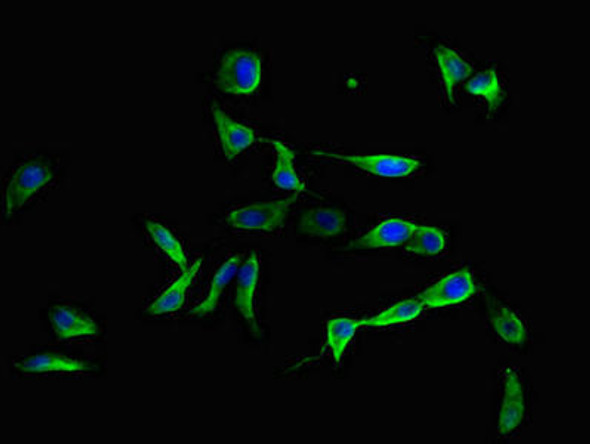EFEMP1 Antibody (PACO22322)
- SKU:
- PACO22322
- Product Type:
- Antibody
- Reactivity:
- Human
- Host Species:
- Rabbit
- Isotype:
- IgG
- Applications:
- ELISA
- WB
- Antibody Type:
- Polyclonal Antibody
- Conjugation:
- Unconjugated
Description
EFEMP1 Antibody (PACO22322)
The EFEMP1 Polyclonal Antibody (PACO22322) from AssayGenie is a valuable tool for researchers studying EFEMP1, a protein associated with extracellular matrix formation and cell adhesion. This antibody, raised in rabbits, has high reactivity with human samples and has been validated for use in various applications, including Western blot and immunohistochemistry.EFEMP1, also known as fibulin-3, is involved in cell proliferation, migration, and tissue development, making it a key player in processes like wound healing and tissue remodeling.
Dysregulation of EFEMP1 has been linked to diseases such as cancer, macular degeneration, and vascular disorders, underscoring its importance in physiological and pathological conditions.By using the EFEMP1 Polyclonal Antibody, researchers can explore the role of EFEMP1 in different cell types and tissues, gaining insights into its function in normal physiology and disease progression. This antibody opens up new possibilities for investigating EFEMP1-related pathways and developing targeted therapies for EFEMP1-associated disorders.
| Antibody Name: | EFEMP1 Antibody (PACO22322) |
| Antibody SKU: | PACO22322 |
| Size: | 100ul |
| Host Species: | Rabbit |
| Tested Applications: | ELISA, WB |
| Recommended Dilutions: | ELISA:1:2000-1:10000, WB:1:500-1:3000 |
| Species Reactivity: | Human |
| Immunogen: | Synthesized peptide derived from internal of human EFEMP1. |
| Form: | Liquid |
| Storage Buffer: | Rabbit IgG in phosphate buffered saline (without Mg2+ and Ca2+), pH 7.4, 150mM NaCl, 0.02% sodium azide and 50% glycerol. |
| Purification Method: | The antibody was affinity-purified from rabbit antiserum by affinity-chromatography using epitope-specific immunogen. |
| Clonality: | Polyclonal |
| Isotype: | IgG |
| Conjugate: | Non-conjugated |
 | Western blot analysis of extracts from rat lung cells, using EFEMP1 antibody. |
| Background: | Binds EGFR, the EGF receptor, inducing EGFR autophosphorylation and the activation of downstream signaling pathways. May play a role in cell adhesion and migration. May function as a negative regulator of chondrocyte differentiation. In the olfactory epithelium, it may regulate glial cell migration, differentiation and the ability of glial cells to support neuronal neurite outgrowth. |
| Synonyms: | EGF-containing fibulin-like extracellular matrix protein 1; Fibulin-3; FIBL-3; Fibrillin-like protein; Extracellular protein S1-5 |
| UniProt Protein Function: | EFEMP1: Binds EGFR, the EGF receptor, inducing EGFR autophosphorylation and the activation of downstream signaling pathways. May play a role in cell adhesion and migration. May function as a negative regulator of chondrocyte differentiation. In the olfactory epithelium, it may regulate glial cell migration, differentiation and the ability of glial cells to support neuronal neurite outgrowth. Defects in EFEMP1 are a cause of Doyne honeycomb retinal dystrophy (DHRD); also known as malattia leventinese (MLVT) (ML). DHRD is an autosomal dominant disease characterized by yellow-white deposits known as drusen that accumulate beneath the retinal pigment epithelium. Belongs to the fibulin family. 4 isoforms of the human protein are produced by alternative splicing. |
| UniProt Protein Details: | Protein type:Secreted; Secreted, signal peptide Chromosomal Location of Human Ortholog: 2p16.1 Cellular Component: extracellular matrix; extracellular region; extracellular space Molecular Function:epidermal growth factor receptor activity; epidermal growth factor receptor binding; protein binding Biological Process: camera-type eye development; embryonic eye morphogenesis; epidermal growth factor receptor signaling pathway; negative regulation of chondrocyte differentiation; peptidyl-tyrosine phosphorylation; post-embryonic eye morphogenesis; regulation of transcription, DNA-dependent; visual perception Disease: Doyne Honeycomb Retinal Dystrophy |
| NCBI Summary: | This gene encodes a member of the fibulin family of extracellular matrix glycoproteins. Like all members of this family, the encoded protein contains tandemly repeated epidermal growth factor-like repeats followed by a C-terminus fibulin-type domain. This gene is upregulated in malignant gliomas and may play a role in the aggressive nature of these tumors. Mutations in this gene are associated with Doyne honeycomb retinal dystrophy. Alternatively spliced transcript variants that encode the same protein have been described.[provided by RefSeq, Nov 2009] |
| UniProt Code: | Q12805 |
| NCBI GenInfo Identifier: | 9973182 |
| NCBI Gene ID: | 2202 |
| NCBI Accession: | Q12805.2 |
| UniProt Secondary Accession: | Q12805,Q541U7, A8K3I4, B4DW75, D6W5D2, |
| UniProt Related Accession: | Q12805 |
| Molecular Weight: | 39,195 Da |
| NCBI Full Name: | EGF-containing fibulin-like extracellular matrix protein 1 |
| NCBI Synonym Full Names: | EGF containing fibulin like extracellular matrix protein 1 |
| NCBI Official Symbol: | EFEMP1 |
| NCBI Official Synonym Symbols: | DHRD; DRAD; FBNL; MLVT; MTLV; S1-5; FBLN3; FIBL-3 |
| NCBI Protein Information: | EGF-containing fibulin-like extracellular matrix protein 1 |
| UniProt Protein Name: | EGF-containing fibulin-like extracellular matrix protein 1 |
| UniProt Synonym Protein Names: | Extracellular protein S1-5; Fibrillin-like protein; Fibulin-3; FIBL-3 |
| UniProt Gene Name: | EFEMP1 |
| Antibodies | ELISA Kits |
| EFEMP1 Antibody (PACO02703) | Human FBLN3(Fibulin-3) ELISA Kit |
| Secondary Antibody |
| Anti-HRP Goat Anti-Rabbit IgG (H+L) Antibody (CABS014) |
| Recommended Products |
| Anti-FITC Goat Anti-Rabbit IgG (H+L) Antibody (CABS011) |
| Anti-HRP-conjugated Beta Actin Antibody (CABC028) |











